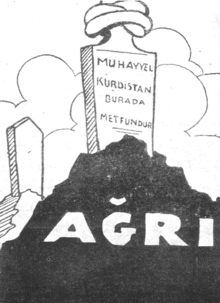Ararat uprising

The Ararat uprising ( Kurdish Serhildanên Agiriyê , Turkish Ağrı ayaklanmaları ) was a series of several uprisings by Kurds in the area of the Ararat .
In the newly founded Republic of Turkey , several uprisings took place under the leadership of Kurdish nationalists and Islamic scholars who fought against the Republic of Turkey. After the suppression of the Sheikh Said uprising , the Ararat area became the center of the Kurds. Many of Sheikh Said's fighters had retired there.
The first uprising
On May 16, 1926, Turkish troops and Kurdish tribal associations collided, which was interpreted as the first Ararat uprising. The 28th Gendarmerie Regiment was badly beaten and withdrew to Doğubeyazıt . Thereupon the 3rd Army started an operation on the Ararat on June 16, which only resulted in a few skirmishes because the Kurds had withdrawn beyond the Iranian border with advance warning . The Ararat uprising was led in particular by Kurdish and Armenian rebels. Kurdish tribes from Iran also took part.
The second uprising
It broke out after September 10, 1927 when the 3rd Army deployed units in the area. Initially the main target was the Ararat, but after information that some Kurdish Aşirets wanted to make their way to the Iranian border, the Turkish army changed its target on September 15. At the border there were then heavy fighting for both sides, so that the Turkish army withdrew again.
The third uprising
In 1930 there was the third and final uprising. In the meantime, the Kurdish organization Xoybûn had declared its intention to support the uprising. To do this, she sent the former Ottoman officer Ihsan Nuri Pasha , who became the general of the uprising. He was able to organize the insurgents, the Xoybûn managed a printing press to Ararat. Magazines such as Agri and Gaziya Welat and a propaganda pamphlet with the title Agri egir dibarine (“The Ararat makes fire rain”) were published, in which the aims of the uprising were explained. In the period after the 2nd uprising, the Republic of Ararat was proclaimed. The Xoybûn appointed General Ibrahim Heski as governor of this republic. Temir Aga became the gendarmerie captain .
On December 28, 1929, the Turkish cabinet decided on military action for June 1930 under General Salih Pasha. Due to the weather and for the purpose of better preparation, the action was postponed to September 1930. Fighting began on September 4th, and this time the Kurdish insurgents lost. They could not withdraw into Iran because an agreement between Turkey and Iran closed the border. Many of the rebels were captured, but Ihsan Nuri Pascha and a few others managed to escape to Iran.
The uprising in the Turkish press
The Cumhuriyet newspaper reported on this uprising and used sensational and racist terms that were common for the time:
"They mix raw meat with a bit of bulgur and are no different from the savages of Africa and the cannibals."
“Our planes bomb the bandits heavily. The Ararat [...] is on fire. The iron wings of the Turks eliminate the rebels. […] The number of people killed in the Zilan maneuver is 15,000. The Zilan Gorge is full of corpses to the top. "
"These [Kurds] may be more talented than the American Indians, but they are bloodthirsty and barbaric ... [...] They have been a plague for our race for centuries."
literature
- Ihsan Nouri Pasha: La révolte de l'Agridagh "Ararat" (1927–1930) . "Agri", éditions kurdes, Genève 1986